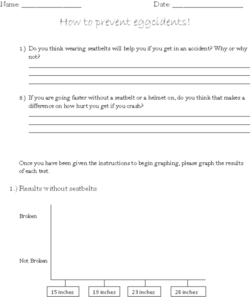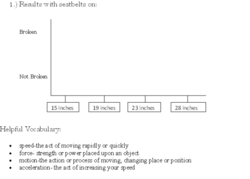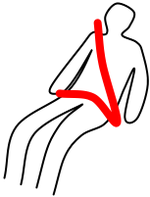How to Prevent Eggcidents
| Instant wiki maker | Making handouts | Editing tips |
Contents
- 1 Student worthiness
- 2 Primary biological content area covered
- 3 Materials
- 4 Description of activity
- 5 Lesson plan
- 6 Seatbelt Safety Connection
- 7 Math connections
- 8 Stronger Science
- 9 Helpful Vocabulary
- 10 Literature connections
- 11 Connections to Vermont educational standards for second grade students
- 12 Potential pitfalls
- 13 Next steps
- 14 Reflections
- 15 Citations and links
Biology In Elementary Schools is a Saint Michael's College student project from a course that ran between 2007 and 2010 and fully described in this book chapter. The student-created resources have been preserved here for posterity. Link under 'toolbox' for printer-friendly versions of the exercises. Click on handouts to print full resolution versions. Please see Wikieducator's disclaimer, our safety statement, and the Creative Commons licensing in English and in legalese.
Student worthiness
tried and trusted.
Primary biological content area covered
Students will...
- Pose a hypothesis and use the scientific method
- Understand the basic concepts of force/motion
- Understand the importance of seatbelts and their role in our safety
- Understand the basic concepts of Newton’s third law "for every action, there is an equal and opposite reaction"
Materials
- Ramp (3 pieces of plexiglass)
- Ruler
- Tape
- Plastic gloves
- Eggs (roughly 4 dozen)
- Binder Clips (4)
- Handout
- Bricks
- Peg Board
- 12 dowels
- Colored Pencils
Description of activity
In this activity students will be learning about the importance of seatbelts. The activity will include students "crashing" a small car bearing a fragile rider (egg). There will be a ramp, set at various heights that the students will send the car flying down. They will see what happens when the passenger doesn't wear their seatbelt and what happens when they do. Students will then then graph the results and analyze the data.
- How to Prevent Eggcidents: Car, Ramp Set Up, and Results
Lesson plan
Pre Lab Setup Students gather together and measure out different heights on the peg board, label the heights and insert the dowels from which to balance the boards. For the pre lab the teacher should build a small model car, see materials for car above, as well as Figures 1-3. Make sure that the ramp is made and bricks are placed at the end of the ramp. Now you are ready to prevent eggcidents!
1.In Class Experiment In class discussion- We will give the students the handout and discuss and answer the first two questions about safety. Once the students have completed the first two questions on the handout, the students will transition to the area where the testing site is located with the peg board and ramp.
2.Testing Without a seatbelt
- Place ramp balancing on the dowels for the level at 15 inches. Place the egg in the car which will be located at the top of the ramp. Prior to testing, we will informally ask the students if they think the egg will break or not.
- Release the car from the top of the ramp and when the car smashes into the bricks, discuss the effects and have students record the data on the graph, which is located on the handout.
- Repeat this process for the height of 19 inches, 23 inches and 28 inches.
3.Testing With a seatbelt
- Place ramp balancing on the dowels for the level at 15 inches. Place the egg in the car with the plastic glove serving as a seatbelt. Prior to the testing, we will informally ask the students if they think the egg will break or not, even with the addition of the seatbelt.
- Release the car from the top of the ramp and when the car smashes into the bricks, discuss the effects and have the students record the data on the second graph, which is located on the handout.
- Repeat this process for the height of 19 inches, 23 inches and 28 inches.
4.Wrap Up
- We will discuss the acceleration of the car due to the increase of gravity. Since the height of the ramp changes there is an increase in acceleration, due to gravity. The longer the incline the faster the car will travel.
- Due to the fact that students in the second grade are not driving a motor vehicle, we will enforce the necessity of wearing a helmet when sledding, biking, skating, and any other form of excessive movement.
<kaltura-widget kalturaid='2tybzkn5y0' size='L' align='L'/>
<kaltura-widget kalturaid='lz8d8rva0w' size='L' align='R'/>
Seatbelt Safety Connection
- When you get into a vehicle, before the key is turned and the vehicle starts, everyone should be buckled up.
- The seatbelt should fit you snugly across your collarbone and hips.
- All children under the age of four must ride in a car seat. It is important to make sure that the car seat fits the child and that it is properly installed in the vehicle.
- Air bags save lives.
- Air bags were designed to work WITH seatbelts to prevent injury to an adult sized person.
- If air bags open in a crash, children in the front seat or in a car seat in the front seat may be seriously injured.
- The safest place for all children under the age of thirteen is in the back seat.[[1]]
Math connections
We are having students measure out the different heights on the peg board. Students work with rulers and labels to make sure that their experiment is carried out thoroughly.
We also will be discussing incline planes. The inclined plane is one of the original six simple machines; as the name suggests, it is a flat surface whose endpoints are at different heights. By moving an object up an inclined plane rather than completely vertical, the amount of force required is reduced, at the expense of increasing the distance the object must travel. The mechanical advantage of an inclined plane is the ratio of the length of the sloped surface to the height it spans; this may also be expressed as the cosecant of the angle between the plane and the horizontal. Note that due to the conservation of energy, the same amount of mechanical energy is required to lift a given object by a given distance, except for losses from friction, but the inclined plane allows the same work to be done with a smaller force exerted over a greater distance. [2] Helpful Safety Site: CPSafety [[3]]
To calculate the forces on an object placed on an inclined plane, consider the three forces acting on it. Air resistance may be neglected for most calculations, except at high speeds. The normal force (N) exerted by the plane onto the body, the force due to gravity (mg - acting vertically downwards) and the frictional force (f) acting parallel to the plane. We can decompose the gravitational force into two vectors, one perpendicular to the plane and one parallel to the plane. Since there is no movement perpendicular to the plane, the component of the gravitational force in this direction (mgcosθ) must be equal and opposite to normal force exerted by the plane, N. If the remaining component of the gravitational force parallel to the surface (mgsinθ) is greater than the static frictional force fs - then the body will slide down the inclined plane with acceleration (gsinθ - fk/m), where fk is the kinetic friction force - otherwise it will remain stationary.
When the slope angle (θ) is zero, sinθ is also zero so the body does not move.Source for Inclined Plane: [[4]]
Stronger Science
Sir Isaac Newton in his work Philosophiæ Naturalis Principia Mathematica, first published on July 5, 1687. In this publication Newton expressed the laws of motion, which are three physical laws that relate directly to the motion of the body. Newton's three physical laws relate directly to our experiment as we worked to explain the science behind an inclined plane and the increased acceleration of the car due to the height of the inclined plane.
Newton's First Law- often referred to as the "Law of Inertia," this law expresses that the movement of an object cannot be changed unless acted upon by an outside force. Without anything pushing or preventing the acceleration of the car, there will be movement without a change in velocity.
Newton's Second Law- this law is often stated as, "Force equals mass times acceleration (F = ma)." When the mass is constant, "the net force on an object is equal to the mass of the object multiplied by its acceleration."
Newton's Third Law- can be summed up with the well-known phrase, "To every action there is an equal and opposite reaction." If you imagine our car driving along at a constant speed and then suddenly it hits the car driving along the opposite side of the road first you will notice the force that our car exerts on the car that it hits (causing a great big crash and maybe even a broken egg!). However, the car that was hit is not the only object that had force exerted on it, it also simultaneously released force of equal magnitude against our car.
We believe that if we were to use this lesson again and had a greater amount of time to teach our students we would expand on our lesson using Sir Isaac Newton's first three laws of motion. All of the information for this section came from: [[5]] which is very informative and helpful in explaining Newton's science!
| Newtons_law | |
| Wikipedia has an article on this subject.
Visit Newtons_law for more in depth information |
| Inclined_plane | |
| Wikipedia has an article on this subject.
Visit Inclined_plane for more in depth information |
Helpful Vocabulary
- speed-the act of moving rapidly or quickly
- force- strength or power placed upon an object
- motion-the action or process of moving, changing place or position
- acceleration- the act of increasing your speed
Literature connections
Here are some great books you might want to check out for your classroom!
1. Gobbell, Phyllis, and Jim Laster. Safe Sally Seat Belt and the Magic Click (Need to Know Books). Chicago: Childrens Pr, 1987.
2. Mattern, Joanne. Staying Safe in the Car (Safety First). New York: Weekly Reader Early Learning Library, 2007.
Figure 11.
Connections to Vermont educational standards for second grade students
S1-2:19 Students demonstrate their understanding of Motion by… ∙ Investigating and describing how objects move in different ways
M2: 25 Organizes and displays data using diagrams, models, tally charts, or tables to answer questions related to the data, to analyze the data to formulate conclusions.
HE2: Core Concepts Students will show an understanding of health promotion and disease prevention concepts and compare behaviors that are safe to those that are risky or harmful (e.g., bicycle and other sport activities, riding in vehicles, handling weapons, fire, appropriate/inappropriate touch).
Potential pitfalls
This experiment may have some difficulty if the eggs for some reason do not break. If the seatbelt puts pressure on the egg and causes it to smash when it goes down the ramp this would lead students to believe that seatbelts can injure a person rather then help them. To make sure that our eggs smashed without a seatbelt and were safe with one on, we tested the eggs several times in the car that we built. We also tested all of the heights and pre-graphed our experiment to make sure that particular levels caused a greater result. Although there are pitfalls to this experiment, they can easily be avoided through preparation.
Next steps
If you have time to expand on this lesson in your classroom there are many fun and interesting elements that can be pulled into this lesson plan. For example, students can build their own model cars using the parts that we have listed under our materials. As long as there is supervision to use the different tools and parts of the car, this is a safe and fun activity. If students fashion their own cars it establishes a personal connection to the car that they will see crashing down the inclined plane. Also, students could decorate the eggs that they send down the inclined plane. This artistic connection to the experiment allows students to channel their creative energy into the lesson. We will then read to the students Safe Sally Seat Belt and the Magic Click (Need to Know Books) and Staying Safe in the Car (Safety First)
Reflections
This experiment worked well! The students were excited to see the eggs crashing and smashing onto the floor. Also, working on the graphs kept them engaged and made a strong science connection as scientists use graphs to record their data. Throughout the experiment students made verbal predictions about whether or not the egg was going to crack as the height of the incline increased. One student made an excellent observation that our cars had two different seats so this may have changed the egg's reaction to the crash. After each lesson we reinforced the learning by discussing seat belt safety and the importance of wearing a helmet when bike riding or sledding. The students also loved the mess and had no problem staying away from the raw egg.
Citations and links
1.http://www.nysgtsc.state.ny.us/Kids/kid-seat.htm
2.http://en.wikipedia.org/wiki/Incline_plane











